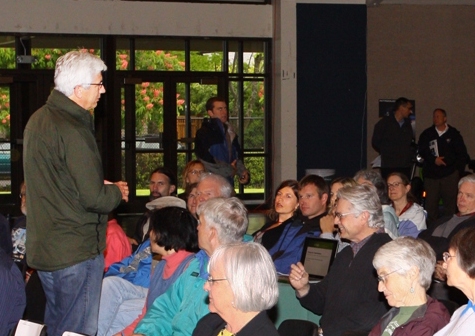'Tipping point or tripping point' for electric vehicles, seminar speaker asks

With its major cities clustered along 100 miles of the Willamette Valley, Oregon offers a fertile ground for electric vehicles and their limited range, George Beard of Portland State University said at a recent presentation. But Oregon’s readiness for electric vehicles doesn’t itself put one electric car on the road.
Beard, with Portland State’s Research & Strategic Partnerships, opened the Center for Transportation Studies’ spring Transportation Seminar Series with the presentation “Electric Vehicles: Are we in the Driver’s Seat?” It’s not just the population centers that make Oregon ripe for electric vehicles, Beard said. Automakers and governments have also invested heavily to deploy the technology in the state.
Oregon spends roughly $6 billion per year on gasoline, with nearly all of that money leaving the state, Beard said. Switching to a locally produced energy source could keep more of that money in the state.
Of course, predicting the future is never that simple, Beard said. Drivers unhappy with congestion won’t see that problem disappear because their cars now run on electricity. “Traffic congestion is a real killer,” he said.
“There’s no silver bullet that will solve our mobility problems,” he said. ”You’ve got to have a number of approaches for being able to move people and goods.”
For a technology that doesn’t require foreign oil, the fate of electric vehicles is intertwined with the oil cartels, Beard said. The Organization of the Petroleum Exporting Countries, or OPEC, might even embrace electric vehicles for keeping automobile dependence thriving.
But slashing gas prices would devastate the budding electric vehicle movement, Beard said. “If I was running OPEC and saw all the companies getting into electric vehicles, I would lower gas prices,” he said. “I would go deflate the EV bubble globally so it wouldn’t take off.”
Nevertheless, big changes are already happening in Oregon, with major car companies introducing models in Oregon before other states and governments preparing the way. The Interstate 5 corridor has around 50 charging stations today, Beard said, but will have 1,000 in eight months.
“We will be one of the most wired corridors in the world,” he said.
Large-scale adoption of electric vehicles requires overcoming the fabled “range anxiety” that causes drivers to fret about running out of juice. So-called DC fast-charge stations, which can recharge a batter 80 percent in 25 minutes, go a long way to address those fears. They still won’t get a driver over distances that lack charging stations, such as much of the Great Plains.
For all their benefits, electric vehicles require more of a change than advocates sometimes acknowledge, Beard said. Their success depends on whether consumers commit despite the tradeoffs. “Will we accept some of the compromises that owning an electric vehicle may require of us?” he said.
